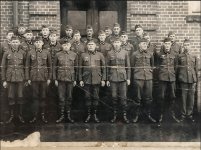Rutche
Senior Member
Hello all, not sure if its right to post here, but I wanted to see if anyone has some takes on this image. I have an X mark on my Great Grandfather who at the time was already quite old, born in 1900. It seems like the other men in the picture are also older. I wonder what an older person like him would be doing in the German military, and what type of unit this was. He lived in a coastal town in Northern Germany, and I wonder if it could be some sort of Kriegsmarine coastal Artillery or similar? I will post this picture hope you might have a few takes.




